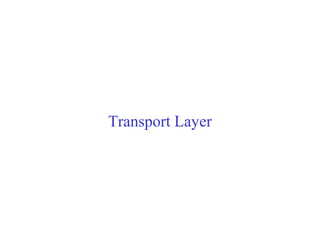Recommended
More Related Content
What's hot
What's hot (20)
Similar to New udp
Similar to New udp (20)
More from Nitesh Singh
More from Nitesh Singh (20)
Project report RAILWAY TICKET RESERVATION SYSTEM SAD

Project report RAILWAY TICKET RESERVATION SYSTEM SAD
New udp
- 2. Position of Transport Layer • Responsible for the delivery of a message from one process to another
- 3. Types of data deliveries • The transport layer is responsible for process-to-process delivery. • Process (application program ??)
- 4. The internetr model has three protocols at the transport layer. UDP – is the simplest protocols TCP – is complex than UDP SCTP – is designed for multimedia applications
- 6. Addressing Address is required for delivery of data Data link layer needs MAC addresses Network layer needs IP addresses Transport layer requires port number
- 7. The internet uses specific port numbers for servers, called well known port numbers.
- 10. Socket address • Process-to-process delivery needs two identifiers, IP address and the port number • Socket address is the combination of an IP address and a port number • A transport-layer protocol needs a pair of socket addresses; the client and server socket address • IP header contains IP address and UDP/TCP contain port number
- 13. Connectionless vs. Connection-oriented • Connection-oriented: connection established, data transferred, connection released – TCP and SCTP • Connectionless: UDP
- 15. Reliability at the data link layer is between two nodes, whereas Reliability at the transport layer is between two ends
- 16. Position of UDP, TCP, and SCTP
- 17. UDP
- 18. Well-known Ports for UDP
- 22. UDP Operation • Connectionless services • Flow and error control • Encapsulation and decapsulation • Queuing
- 25. Use of UDP • Suitable for a process that requires simple request-response communication with little concern for flow and error control, not suitable for FTP which sends a bulk of data. • Suitable for a process with internal flow and error control mechanisms such as TFTP( ) • Suitable for multicasting. Multicasting is available in UDP but not in TCP. • Used for management processes such as SNMP • Used for some route updating protocols such as RIP

